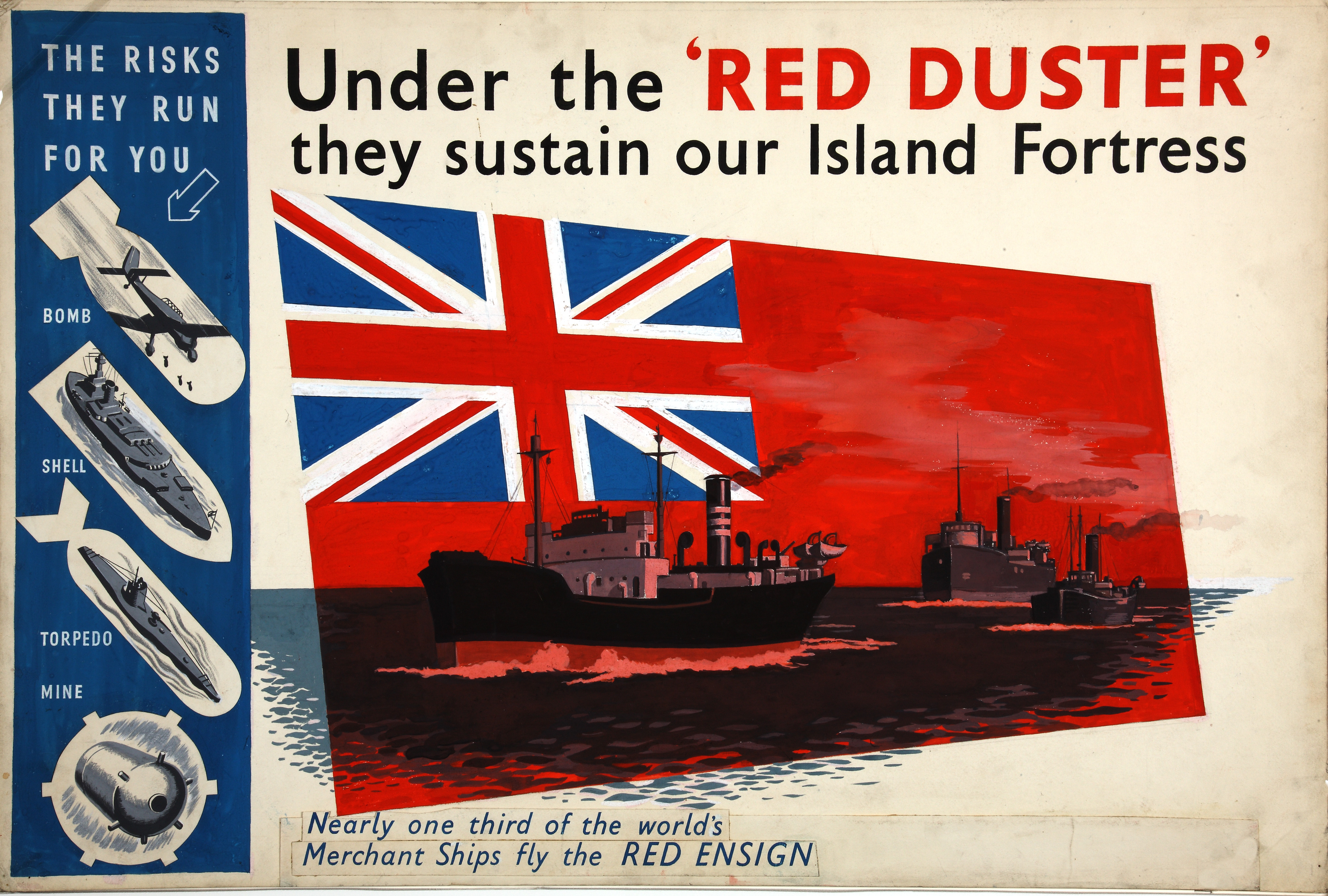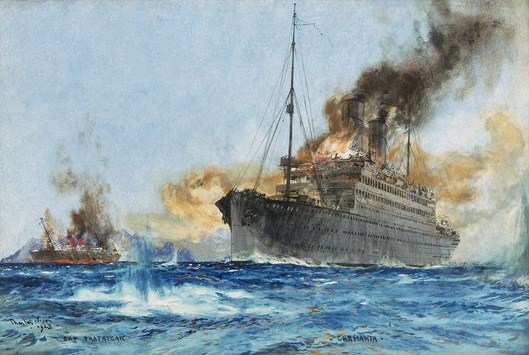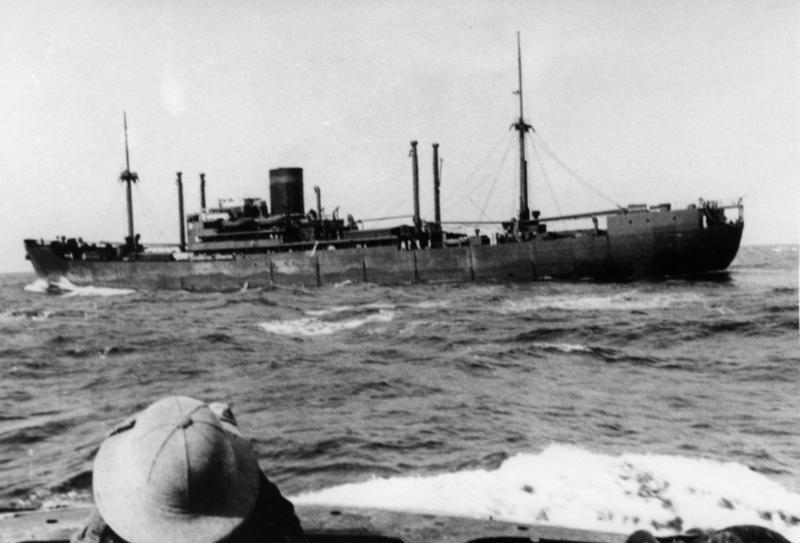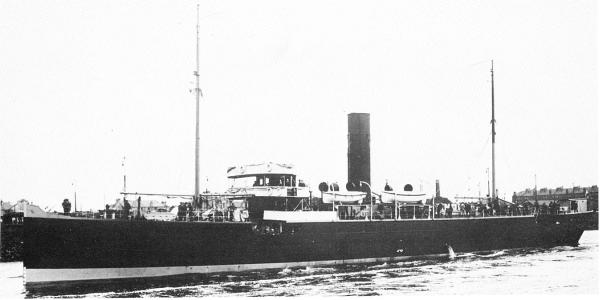|
Armed Merchant Ship
The term armed merchant ship may describe a number of similar ship modifications intended for significantly different missions. The term armed merchantman is generally used. * East Indiaman describes late 18th and early 19th-century sailing ships engaged in trade while carrying guns similar to contemporary warships. * Defensively Equipped Merchant Ships were civilian-crewed cargo ships carrying a small number of military personnel to operate an anti-submarine gun and anti-aircraft machine guns during the world wars of the early 20th century. * Auxiliary cruisers were cargo ships commissioned as naval vessels with a military crew, converted to carry the guns of a light cruiser, and sometimes used as Merchant raiders. * Armed merchant cruisers were fast passenger liners commissioned as naval vessels with a military crew and converted to carry the guns of a light cruiser. * Naval trawlers were fishing trawlers commissioned as naval vessels with a military crew and equipped for mineswee ... [...More Info...] [...Related Items...] OR: [Wikipedia] [Google] [Baidu] |
Armed Merchantman
An armed merchantman is a merchant ship equipped with guns, usually for defensive purposes, either by design or after the fact. In the days of sail, piracy and privateers, many merchantmen would be routinely armed, especially those engaging in long distance and high value trade. In more modern times, auxiliary cruisers were used offensively as merchant raiders to disrupt trade chiefly during both World War I and World War II, particularly by Germany. While armed merchantmen are clearly inferior to purpose-built warships, sometimes they have scored successes in combat against them. Examples include East Indiamen mimicking ships of the line and chasing off regular French warships in the Battle of Pulo Aura in 1804, and the sinking the Australian light cruiser in their battle in 1941, although ''Kormoran'' was also destroyed and had to be scuttled. Pre-20th century East Indiamen of various European countries were heavily armed for their long journeys to the Far East. In parti ... [...More Info...] [...Related Items...] OR: [Wikipedia] [Google] [Baidu] |
East Indiaman
East Indiaman was a general name for any sailing ship operating under charter or licence to any of the East India trading companies of the major European trading powers of the 17th through the 19th centuries. The term is used to refer to vessels belonging to the Austrian, Danish, Dutch, English, French, Portuguese, or Swedish companies. Some of the East Indiamen chartered by the British East India Company were known as "tea clippers". In Britain, the East India Company held a monopoly granted to it by Queen Elizabeth I of England in 1600 for all English trade between the Cape of Good Hope and Cape Horn. This grant was progressively restricted during the late 18th and early 19th centuries, until the monopoly was lost in 1834. English (later British) East Indiamen usually ran between England, the Cape of Good Hope and India, where their primary destinations were the ports of Bombay, Madras and Calcutta. The Indiamen often continued on to China before returning to England via t ... [...More Info...] [...Related Items...] OR: [Wikipedia] [Google] [Baidu] |
Defensively Equipped Merchant Ships
Defensively equipped merchant ship (DEMS) was an Admiralty Trade Division programme established in June 1939, to arm 5,500 British merchant ships with an adequate defence against enemy submarines and aircraft. The acronym DEMS was used to describe the ships carrying the guns, the guns aboard the ships, the military personnel manning the guns, and the shore establishment supporting the system. Background In the eighteenth and nineteenth centuries, European countries such as Spain, France, the Netherlands and Britain armed their merchant ships to prevent capture by pirates, enemy commerce raiders and privateers when they conducted overseas trade. The most heavily armed were ships carrying valuable cargo back from the Far East. Notably the East Indiamen class of ships were constructed from the keel up with defence in mind, with their heavy armament making some of the most powerful examples equivalent to naval Fourth-rate ships of the line. After the end of the Napoleonic Wars in 18 ... [...More Info...] [...Related Items...] OR: [Wikipedia] [Google] [Baidu] |
Merchant Raiders
Merchant raiders are armed commerce raiding ships that disguise themselves as non-combatant merchant vessels. History Germany used several merchant raiders early in World War I (1914–1918), and again early in World War II (1939–1945). The captain of a German merchant raider, Felix von Luckner, used the sailing ship SMS ''Seeadler'' for his voyage (1916–1917). The Germans used a sailing ship at this stage of the war because coal-fired ships had limited access to fuel outside of territories held by the Central Powers due to international regulations concerning refueling of combat ships in neutral countries. Germany sent out two waves of six surface raiders each during World War II. Most of these vessels were in the range. Many of these vessels had originally been refrigerator ships, used to transport fresh food from the tropics. These vessels were faster than regular merchant vessels, which was important for a warship. They were armed with six 15 cm (5.9 inch) naval ... [...More Info...] [...Related Items...] OR: [Wikipedia] [Google] [Baidu] |
Armed Merchant Cruiser
An armed merchantman is a merchant ship equipped with guns, usually for defensive purposes, either by design or after the fact. In the days of sail, piracy and privateers, many merchantmen would be routinely armed, especially those engaging in long distance and high value trade. In more modern times, auxiliary cruisers were used offensively as merchant raiders to disrupt trade chiefly during both World War I and World War II, particularly by Germany. While armed merchantmen are clearly inferior to purpose-built warships, sometimes they have scored successes in combat against them. Examples include East Indiamen mimicking ships of the line and chasing off regular French warships in the Battle of Pulo Aura in 1804, and the sinking the Australian light cruiser in their battle in 1941, although ''Kormoran'' was also destroyed and had to be scuttled. Pre-20th century East Indiamen of various European countries were heavily armed for their long journeys to the Far East. In part ... [...More Info...] [...Related Items...] OR: [Wikipedia] [Google] [Baidu] |
Naval Trawler
Naval trawlers are vessels built along the lines of a fishing trawler but fitted out for naval purposes; they were widely used during the First and Second World Wars. Some—known in the Royal Navy as "Admiralty trawlers"— were purpose-built to naval specifications, others adapted from civilian use. Fishing trawlers were particularly suited for many naval requirements because they were robust vessels designed to work heavy trawls in all types of weather, and had large clear working decks. A minesweeper could be created by replacing the trawl with a mine sweep. Adding depth charge racks on the deck, ASDIC sonar below, and a or gun in the bow equipped the trawler for anti-submarine duties. History Armed trawlers were also used to defend fishing groups from enemy aircraft or submarines. The smallest civilian trawlers were converted to danlayers. Contemporary Some nations still use armed trawlers for fisheries protection and patrol. The Indian Navy used naval trawlers for ... [...More Info...] [...Related Items...] OR: [Wikipedia] [Google] [Baidu] |
Q-ship
Q-ships, also known as Q-boats, decoy vessels, special service ships, or mystery ships, were heavily armed merchant ships with concealed weaponry, designed to lure submarines into making surface attacks. This gave Q-ships the chance to open fire and sink them. The use of Q-ships contributed to the abandonment of cruiser rules restricting attacks on unarmed merchant ships and to the shift to unrestricted submarine warfare in the 20th century. They were used by the British Royal Navy and the German ''Kaiserliche Marine'' during the First World War and by the Royal Navy, the '' Kriegsmarine'', and the United States Navy during the Second World War (1939–45). Etymology Short for Queenstown in Ireland, as Haulbowline Dockyard in Cork Harbour was responsible for the conversion of many mercantile steamers to armed decoy ships in World War One, although the majority appear to have been converted in larger navy yards such as Devonport. Early uses of the concept In the 1670s, ... [...More Info...] [...Related Items...] OR: [Wikipedia] [Google] [Baidu] |
Armed Boarding Steamer
An armed boarding steamer (or "armed boarding ship", or "armed boarding vessel") was a merchantman that the British Royal Navy converted to a warship during the First World War. AB steamers or vessels had the role of enforcing wartime blockades by intercepting and boarding foreign vessels. The boarding party would inspect the foreign ship to determine whether to detain the ship and send it into port or permit it to go on its way. Origins On 28 September 1914 Admiral John Jellicoe, commander-in-chief of the Grand Fleet, sent a telegram in which he pointed out that he did not have enough destroyers available to enforce the blockade. Furthermore, the weather was often too severe for the destroyers. Although Jellicoe did not mention it, after the loss on 22 September of the cruisers , and , he also did not want large warships making themselves sitting targets for submarines by stopping to examine merchant vessels. The first request was for 12 vessels, all to be capable of , be abl ... [...More Info...] [...Related Items...] OR: [Wikipedia] [Google] [Baidu] |
Boarding (attack)
Naval boarding action is an offensive tactic used in naval warfare to come up against (or alongside) an enemy marine vessel and attack by inserting combatants aboard that vessel. The goal of boarding is to invade and overrun the enemy personnel on board in order to capture, sabotage or destroy the enemy vessel. While boarding attacks were originally carried out by ordinary sailors who are proficient in hand-to-hand combat, larger warships often deploy specially trained and equipped regular troops such as marines and special forces as boarders. Boarding and close quarters combat had been a primary means to conclude a naval battle since antiquity, until the early modern period when heavy naval guns gained tactical primacy at sea. A cutting out boarding is an attack by small boats, preferably at night and against an unsuspecting, and anchored, target. It became popular in the later 18th century, and was extensively used during the Napoleonic Wars. This heralded the empha ... [...More Info...] [...Related Items...] OR: [Wikipedia] [Google] [Baidu] |
Auxiliary Cruisers
An armed merchantman is a merchant ship equipped with guns, usually for defensive purposes, either by design or after the fact. In the days of sail, piracy and privateers, many merchantmen would be routinely armed, especially those engaging in long distance and high value trade. In more modern times, auxiliary cruisers were used offensively as merchant raiders to disrupt trade chiefly during both World War I and World War II, particularly by Germany. While armed merchantmen are clearly inferior to purpose-built warships, sometimes they have scored successes in combat against them. Examples include East Indiamen mimicking ships of the line and chasing off regular French warships in the Battle of Pulo Aura in 1804, and the sinking the Australian light cruiser in their battle in 1941, although ''Kormoran'' was also destroyed and had to be scuttled. Pre-20th century East Indiamen of various European countries were heavily armed for their long journeys to the Far East. In parti ... [...More Info...] [...Related Items...] OR: [Wikipedia] [Google] [Baidu] |







.jpg)
.jpg)